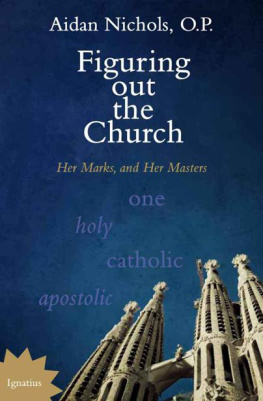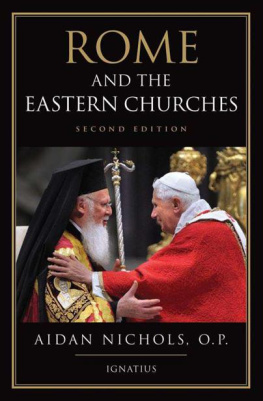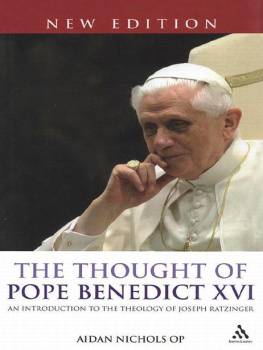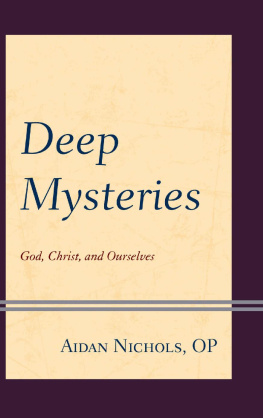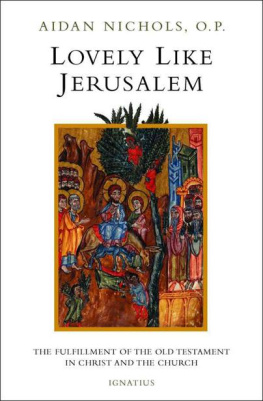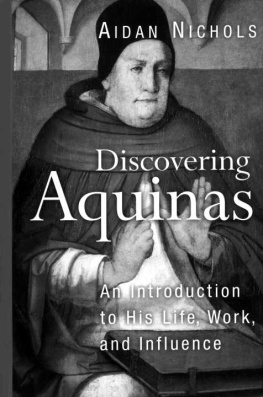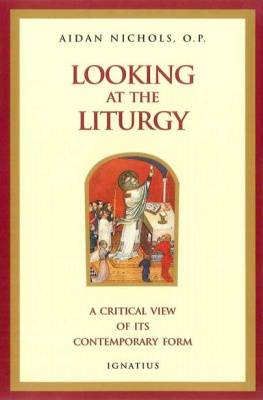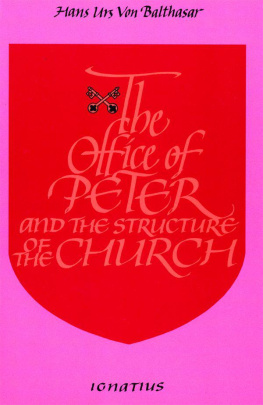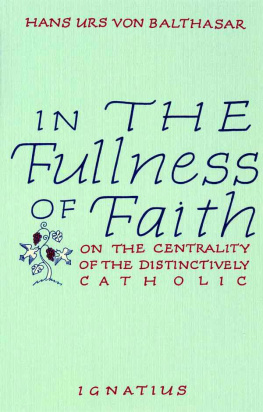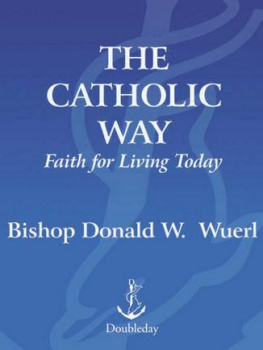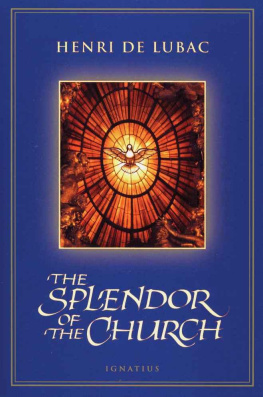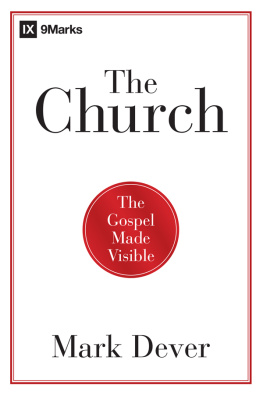FIGURING OUT THE CHURCH
AIDAN NICHOLS, O.P.
FIGURING OUT
THE CHURCH
Her Marks and Her Masters
IGNATIUS PRESS SAN FRANCISCO
Unless otherwise noted, Scripture quotations (except those within citations) have been taken from the Revised Standard Version of the Holy Bible, Second Catholic Edition, 2006. The Revised Standard Version of the Holy Bible: the Old Testament, 1952, 2006; the Apocrypha, 1957, 2006; the New Testament, 1946, 2006; the Catholic Edition of the Old Testament, incorporating the Apocrypha, 1966, 2006, the Catholic Edition of the New Testament, 1965, 2006 by the Division of Christian Education of the National Council of the Churches of Christ in the United States of America. All rights reserved.
Cover photograph:
Basilica de la Sagrada Familia
Barcelona, Spain
istockphoto/Roberto A. Sanchez
Cover design by Roxanne Mei Lum
2013 by Ignatius Press, San Francisco
All rights reserved
ISBN 978-1-58617-818-5
Library of Congress Control Number 2013941180
Printed in the United States of America
CONTENTS
PART I
HER MARKS
PART II
HER MASTERS
PREFACE
OF MARKS AND MASTERS
The most obvious way in which to discuss the Church is by reference to the way in which the Creed describes her: one, holy, catholic, and apostolic. In a vocabulary which the opening pages of this book will seek to explain, these are her four characteristic signs, notes, or, in the word preferred here, her marks.
Readers of the work of the French Dominican Cardinal Yves Marie-Jean Congar will realise my debt to that immensely learned historian of ecclesiology, the discipline which studies what, for Christian doctrine, the Church is. It was my good fortune to have profited from several meetings with him at the Couvent Saint-Jacques (and subsequently at Les Invalides) when I was working on a study of a Russian Orthodox ecclesiologist. I have followed the main lines of his teaching (typical of his middle period) on the marks of the Church. But I have also added enrichments from the dogmatic thought of other authors, whether Scholastic or those under the influence of la nouvelle thologie .
This description covers the first half of this book. That the concepts used in the ecclesiologies of the Catholic divines often go beyond formal discussion of the four marks suggests the need, however, to figure out the Church by scanning more widely the ways in which her masters have spoken of her: hence the complement to an account of the marks of the Church as provided in the remainder of this modest work.
Once again, I appeal to both the Scholastic tradition and authors influenced by the ressourcement movement. I hope that the quartet of masters I have chosen suffices to give readers a breath from a Catholicism that is at once orthodox and generously conceived. These chapters constitute relatively short studies. I cannot possibly hope to do justice to everything they have written relevant to this theme. But there is enough here for my purpose.
I ought to add that, by referring to the Church as she (as with her marks, her masters), it can hardly be overlooked that language about the Church also dwells in symbols and deep metaphors, and not just in concepts and argumentative ratiocination.
In my experience, it is not always easy to love the Church considered as an empirical quantity. But it is, I find, always easy to love her considered as a theological reality. For seen so, she is the Bride of Christ, radiant and crowned with flowers. My conclusion is just about that.
A. Nichols, O.P.
Blackfriars, Cambridge
Solemnity of Pentecost, 2012
PART I
HER MARKS
1
THE UNITY OF THE CHURCH
General Introduction
The Creed of Nicaea-Constantinoplethe Great Creed, recited for preference whenever there is a confession of faith at Masscalls the Church one, holy, catholic, and apostolic. Given that Christian theology is essentially a commentary on the Creed, understood as a summary of Scripture, we should not be surprised to find that much literary production in ecclesiologythe discipline whereby we figure out what the Church ishas taken its structure from these four adjectives.
It is important to noticenot least for the enquiry I have set myself in this small bookthat the adjectives in question may be thought of in a number of different ways. The unity, holiness, catholicity, and apostolicity of the Church can be thought of ontologically , as four constituent features of the Churchs essence. And they can be thought of epistemologically , as four signsthe word commonly used is marks or noteswhereby we can identify the Church (the true Church, as people say), i.e., know that the community we are talking about really is the Church of the Creed, and, behind the Creed, the Bible.
Moreover, those four adjectivesone, holy, catholic, apostoliccan also be thought of pedagogically , as a convenient set of pegs on which to hang whatever it is we wish to say theologically about the Church. Lastly, they can be thought of eschatologically , as dimensions of the Church which will receive their full amplitude only in the Age to Come, in that ultimate, consummated existence which belongs to the heavenly Jerusalem.
These optionsontological, epistemological, pedagogical, eschatologicalare in no way mutually exclusive. On the contrary, they cry out (this at any rate is my conviction) for being put together in synthesis . If unity, holiness, catholicity, and apostolicity really belong to the Church (the ontological approach), then they will surely manifest themselves in some fashion (the epistemological approach), offering themselves as reference points for whatever else we want to say about the Church (the pedagogical approach), but always with the proviso that any Christian ontologyany account of reality in the light of the Gospelwill need to be open to divine completion from without at the Parousia of the Lord (the eschatological approach).
Preamble to the Mark of Unity
Among the four marks of the Church, the ecumenical Creedas distinct from the less universally used Old Roman or Apostles Creedopts decisively for unity as the primordial feature of the Church of God. The Great Creed has already introduced its confession of the Trinitarian life and activity of Father, Son, and Holy Spirit by proclaiming its belief in one God, a belief which, significantly, names first the Father as the fount of the Son and Spirit. I say significantly because that fontal position of the Father is crucial to the very constitution of the Trinity.
These two credenda one Church and one God, named as Father of Son and Spiritare not of course unrelated. There is in some quarters today a tendency to give relative priority to the inner diversity of the Church rather than to her unity, to consider her differentiation in the form of multiple local churches, each with (ideally) its own distinctive life, to be a more interesting theological consideration than the unity of which the Creed speaks.
Not that people deny outright the unity of the Church, the need for the Church to correspond in some way to the mark of oneness. But they are inclined to think of that unity as something constructed from out of the diversity of the many local churches of the Catholic Church: an aspect of their interrelations rather than of their prior productive ground.
To be theologically consistent, ecclesiologiesor, more modestly, extended comments on Church lifewhich run along these lines probably require a reconstruction of Trinitarian doctrine whereby the Holy Spirit, the Distributor of multiform gifts, will henceforth be treated as the specific Trinitarian Person who ought to occupy the foreground of Christian thinking about God. In that case, the Father, who in reality is the Source of the Spirit, will be regarded as, in effect, the presupposition (merely) of the Spirit and thus, relatively speaking, fade into the background. It is not easy to get excited about a presupposition! But such a frank reversal of the Trinitarian ordering, which moves essentially from the Father, who as Father is Father of the Son, to the Holy Spirit, finds no support (to the regret of advocates of radically pluralist ecclesiology) in the pattern of the Creed. Thus any theology that considers itself to consist in obedient reflection on the Creed as a summary of Scripture, and in that way to be an expression of the Word of God, cannot make room for the reversal. This observation about the theology of the Trinity teaches us, I believe, an important ecclesiological lesson.
Next page
